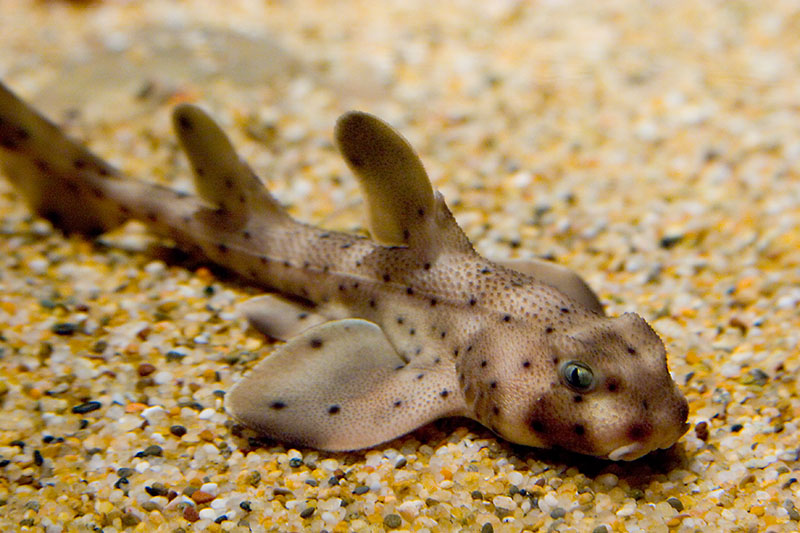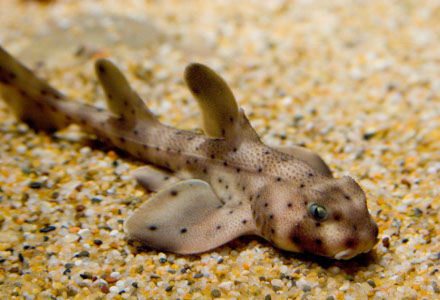
Horn Shark Facts
- For understandable reasons, this intriguing product of Nature and evolution bears the simple yet descriptive common name of the Horn Shark. The official scientific name for it, however, as is so often the case, doesn’t roll of the tongue quite so easily.
- That’s due to the fact that professional researchers know it best by the term of Heterodontus francisci. It originally bore another name, though. The respected French biologist, Charles Frederic Girard made the first formal recognition of it as a species.
- This scientifically noteworthy event occurred in the year 1855. At that time, he named it Cestracion francisci. That name, however, subsequently changed several times. The assignment of the official moniker it bears now actually took place many years later.
- For the moment, the IUCN has no official listing for the creature on its Red List of Threatened Species. It’s presently formally noted as Data Deficient. Ongoing research, though, will hopefully redress the lamentable lack of information in this area.
- Thankfully, the Horn Shark isn’t intentionally fished, either commercially or recreationally. Small numbers do sometimes fall victim accidental bycatch, however. The shark is nevertheless sometimes used as fishmeal in parts of its endemic range.
- The remarkable fish nonetheless does face some potential threats to its continued existence, though. Like most species around the world, it’s potentially at risk due to climate change. Because of the nature of its range, habitat loss also poses a danger.
Related Articles
Horn Shark Physical Description
Although the amazing Horn Shark certainly impresses those who encounter it, it doesn’t do so due to sheer size. That’s because this particular animal ranks as moderately small for its kind. It nonetheless possesses its own share of impressive physical characteristics.
This fascinating creature, like most of its kindred, manifests a small degree of the physiological characteristic of sexual dimorphism. In its case, again following the typical pattern of its genus, this manifests in terms of a difference in size, though this remains small.
More specifically, the females generally attain a slightly greater length than their male counterparts. The females further reach an average length of about 3.3 ft (1 m). Exceptional specimens do occur, however, sometimes measuring as much as 3.9 ft (1.2 m).
Forming a variety of what’s known as a bullhead shark, the animal has a short, relatively wide head. It also displays a blunt snout, with pronounced ridges over its eyes. The mouth develops as small and somewhat curved, with strong furrows appearing at the corners.
Intriguingly, the body of the Horn Shark most commonly has a strongly cylindrical form to it. This body further displays two high dorsal fins, with strong, sharp spines. Color further varies significantly between individuals, though some patterns naturally predominate.
These typically consist of yellowish on the bottom, and shades of brown or gray otherwise. Numerous small dark spots also dot the body at random. These markings, however, often disappear as it ages. Yet another small patch of dark spots appears below both of its eyes.
- Kingdom: Animalia
- Phylum: Chordata
- Class: Chondrichthyes
- Order: Heterodontiformes
- Family: Heterodontidae
- Genus: Heterodontus
- Species: H. francisci
Horn Shark Distribution, Habitat, and Ecology
Regrettably, the fabulous Horn Shark inhabits a comparatively restricted portion of the oceans of the world. That’s due to the fact that it only appears in a small portion of the eastern Pacific Ocean. That’s the continental shelf, off the east coast of North America.
Even there, though, this marvel only lives in a limited range, to the knowledge of researchers. The bullhead shark appears to live in a range that begins off the coast of California, in the United States. From there, this further extends to the Gulf of California, in Mexico.
As a general rule, the species lives in extremely shallow waters in its range. Throughout most of the year, it typically appears ata depths ranging from 6.6 – 36.1 ft (2 – 11 m). During the winter months, however, the anaimal migrates to depths greater than 98 ft (30 m).
It most frequently makes its home in regions of either algae beds or complex rocky reefs. Some specimens, though, have been spotted in caves, at depths of up to 660 ft (200 m) in winter. It also often makes use of moderately large pits dug out by various species of ray.
Individuals of this remarkable species further remain strongly benthic in nature. As a result of this trait, most specimens rarely move more than 6.6 ft (2 m) from the ocean floor. Interestingly, as a general principle, individuals migrate to shallower waters as they age.
The Horn Shark only swims sporadically, as a rule. Although small groups have been spotted, it most commonly lives a highly solitary life. The majority of its diet consists of hard-shelled mollusks and crustaceans. It also eats small quantities of sea stars and peanut worms.
Species Sharing Its Range
Check out our other articles on 3 Blatantly Beautiful Bumblebees, Great Barracuda, Sicilian Fir, Philippine Crocodile, Kauai hau kuahiwi, Porites lutea, 5 Amazing Asian Amphibians

